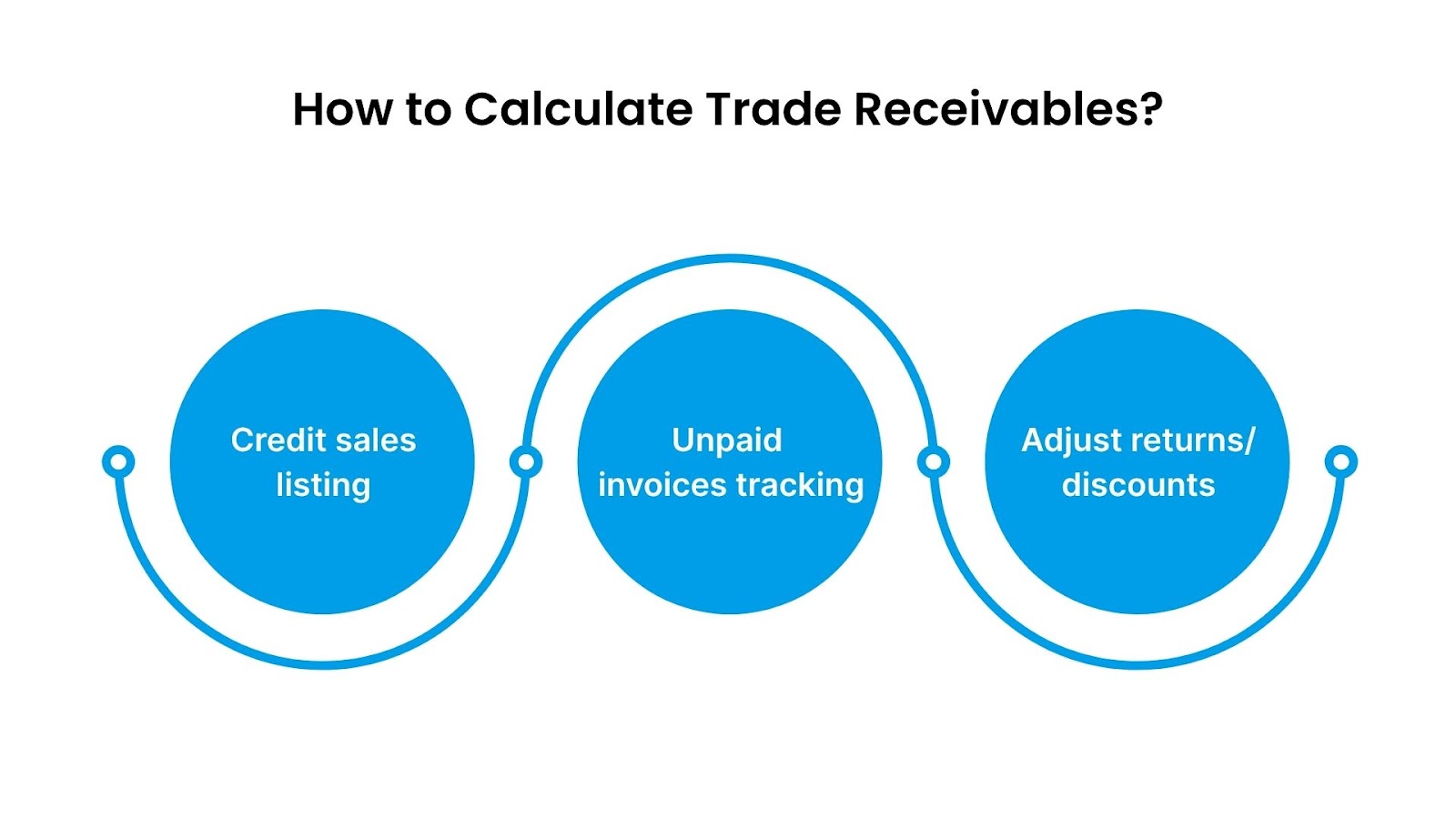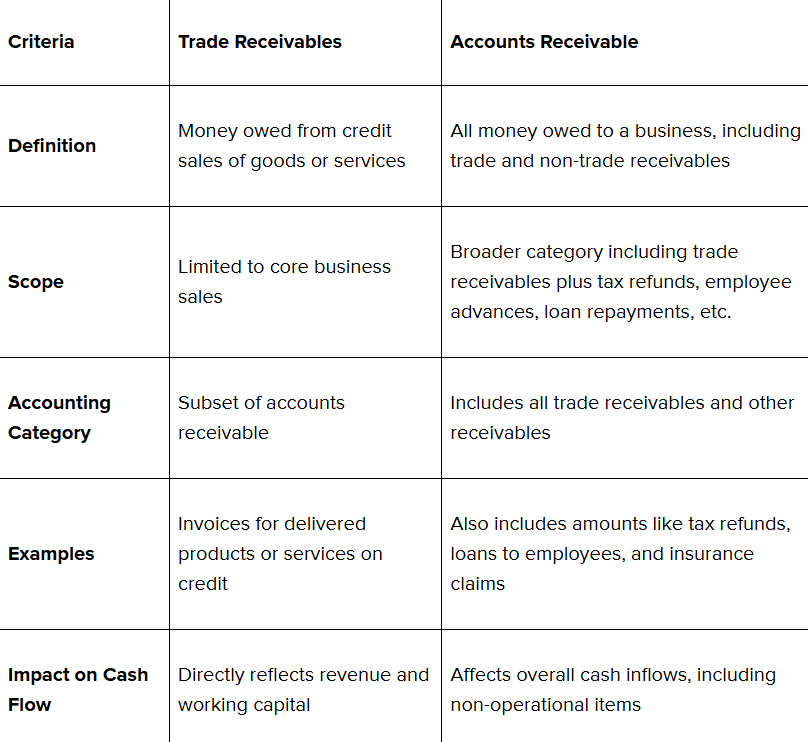Difference Between Trade Receivables and Accounts Receivable
Difference Between Trade Receivables and Accounts Receivable

Transform Your Financial Future
Contact UsHave you ever looked at your company's bills and wondered why your cash isn't adding up?
Perhaps you've sent out some invoices and are now waiting for customers to pay you. Or, maybe you see a list of people who owe you money, but you're not sure who they are. If the words "trade receivables vs accounts receivable" make you scratch your head, don't worry, you're not alone! You might also be asking, "Is trade receivables the same as accounts receivable?"
These might sound like big accounting words, but they are really just ways to help you keep track of your money. Knowing the difference can help your business maintain a steady cash flow and avoid problems later on. Want to know how these simple ideas can help your business?
Let's learn what these words really mean and why understanding them can make a big difference for your financial health!
Key Takeaways
- Trade receivables are amounts owed from core credit sales; accounts receivable include these plus other receivables like loans or tax refunds.
- Knowing the difference helps improve cash flow, credit risk management, and financial reporting accuracy.
- Manage receivables effectively by organizing them early, setting clear payment terms, automating tracking, following up promptly, and regularly reviewing receivable health.
- Distinguishing key differences and similarities enables focused financial control and better decision-making.
- Working with experts like The Forest Hill Management enhances collections and compliance, supporting your business's financial stability.
What Are Trade Receivables?
Trade receivables represent money owed to a business, specifically from credit sales of goods or services that are part of the company's core operations. When a company extends credit to customers and delivers products or services, the amount that customers have yet to pay is recorded as trade receivables.
Knowing what trade receivables are is important, but learning how to accurately calculate them ensures you keep a clear picture of what customers still owe.
How to Calculate Trade Receivables?

Understanding how to calculate trade receivables is crucial for tracking the money your business expects to receive. Trade receivables are calculated by adding up all unpaid invoices issued to customers for goods sold or services provided on credit. In simple terms, it's the total amount customers still owe you.
This can be represented as:
Trade Receivables = Debtors + Bill Receivables
- Debtors are customers with overdue payments.
- Bill Receivables are invoices still within their payment terms.
Simple Steps
- List all credit sales made.
- Add all unpaid invoices, including both overdue and current ones.
- Subtract any returns or discounts.
Example
Your company sold products to three customers:

Total trade receivables = $500 + $1,000 + $500 = $2,000
This figure shows how much money you expect from regular credit sales.
Why This Matters?
Understanding trade receivable vs accounts receivable is crucial for managing your core business cash flow. Trade receivables cover amounts owed for regular sales, while accounts receivable also include other receivables such as tax refunds or employee advances.
Next, let's understand accounts receivable, which include trade receivables plus other amounts owed from various sources, providing a view of what your business expects to receive.
What Are Accounts Receivable?
Accounts receivable is the total amount of money a business is owed by customers or others for goods delivered or services provided but not yet paid for. This includes trade receivables (money from credit sales) plus other amounts such as loan repayments, security deposits, or rent receivables.
Accounts receivable are recorded as a current asset because they are expected to be collected within one year. Understanding trade receivables vs accounts receivable is important because all trade receivables are part of accounts receivable, but accounts receivable cover a broader range of owed amounts.
This distinction helps businesses keep track of core sales revenue separately from other receivables, which is essential for accurate financial management and cash flow monitoring.
Now that you know what each term means, let's compare trade receivables vs accounts receivable to see how they differ and where they overlap in impact and management.
Trade Receivables vs. Accounts Receivable: Differences and Similarities Compared
Understanding the difference between trade receivables vs accounts receivable is crucial for effective financial management. Although these terms are often used interchangeably, they have important distinctions that affect how a business manages cash flow, tracks revenue, and prepares financial reports.
Grasping the differences and similarities between these terms helps you:
- Track income from actual sales vs. other amounts owed.
- Make better decisions about lending credit.
- Report finances clearly to your team or to external auditors.
- Spot risks by understanding what portion of your receivables is tied to ongoing business activity.
Without a clear understanding, you might misjudge your expected cash inflows or miss warning signs in your receivables. Let's break down the comparisons to clarify the points.
Trade Receivables vs. Accounts Receivable: Key Differences
Recognizing this distinction enables more focused credit management, sharper financial reporting, and improved cash flow forecasting. It ensures you separate revenues from regular business activities from other receivables that may have different collection patterns or risks.
Here’s what sets them apart:

While different, these receivables share important features that require consistent monitoring and credit control to maintain healthy business liquidity.
Trade Receivables vs. Accounts Receivable: Key Similarities
Despite their differences, trade receivables and accounts receivable share important traits. Both represent expected payments and are recorded as current assets on the balance sheet. Each requires diligent monitoring, credit risk management, and collection efforts to maintain healthy cash flow.
Let’s look at the key similarities:

To fully understand accounts receivable, it is helpful to review common non-trade receivables, which are amounts not linked to sales but are still crucial to your financial situation.
Examples of Nontrade Receivables
Nontrade receivables are amounts owed to a business that don't come from the sale of goods or services, unlike trade receivables. They represent money expected from other sources outside normal credit sales.
Here are some common examples of nontrade receivables that businesses often encounter:
- Interest Receivable: Money earned as interest on loans, investments, or deposits but not yet received.
- Income Tax Receivable: Refunds expected from tax authorities when a business has overpaid taxes.
- Insurance Claims Receivable: Amounts due from insurance companies after a claim has been approved but before payment.
- Receivables from Employees: Loans or advances given to employees that they need to repay, such as salary advances or personal loans.
Understanding these examples helps separate routine sales-related receivables from other owed amounts, improving financial reporting and cash flow management.
With a clear understanding of the types involved, let's see practical strategies to organize, monitor, and manage your receivables effectively, thereby enhancing your overall financial health.
How to track and manage trade and accounts receivable

Effectively managing trade receivables vs accounts receivable is essential to maintain healthy cash flow and ensure your business stays financially strong. Tracking these receivables properly helps you monitor outstanding payments, reduce delays, and improve collections. Here are key steps to track and manage your receivables efficiently:
1. Organize your receivables from day one
Set up a clear system to record all receivables separately, trade receivables for credit sales, and non-trade amounts within accounts receivable. This initial organization makes monitoring easier and helps you distinguish between operational sales revenues and other receivables.
2. Set clear payment terms upfront
Communicate precise payment terms (due dates, discounts for early payments, penalties for late payments) when invoicing customers. Clear terms create expectations that minimize payment delays, helping improve your trade receivables vs accounts receivable collection efficiency.
3. Automate tracking to avoid bottlenecks
Use accounting software or receivables management tools to automate invoice tracking, sending reminders, and updating payment status. Automation reduces manual errors, accelerates follow-ups, and provides real-time visibility into outstanding trade receivables and other accounts receivable.
4. Stay on top of follow-ups
Proactively follow up on overdue invoices to speed up collections. Tailor your approach depending on whether it's a trade receivable related to core sales or a non-trade receivable. Timely communication helps reduce days sales outstanding (DSO) and strengthens customer relationships.
5. Regularly review your receivables health
Schedule frequent reviews to analyze aging reports for both trade and accounts receivable, identifying overdue accounts or trends indicating payment risks. Use these insights to adjust credit policies, improve forecasting, and make informed financial decisions.
Implementing these strategies improves your management of trade receivables vs accounts receivable, while expert services like The Forest Hill Management help reduce bad debts and support confident planning and investing.
How The Forest Hill Management Can Help Your Business and Financial Needs

The Forest Hill Management is a trusted leader with over two decades of experience specializing in receivables management and financial services. They provide tailored solutions to help individuals and businesses resolve overdue accounts and regain financial control.
Let's explore their key services:
- Receivables Management & Debt Resolution: They assist creditors in recovering unpaid accounts by offering personalized payment solutions that balance efficient collection with maintaining positive client relationships.
- Portfolio Management: The company streamlines and optimizes the handling of financial portfolios, ensuring accurate and effective management of outstanding receivables.
- Portfolio Acquisitions: Forest Hill Management conducts due diligence and manages debt portfolio acquisitions, supporting investors and financial institutions in growing and managing their assets compliantly.
- Compliance & Technology: Emphasizing data security and regulatory adherence, their technology-driven approach ensures all processes meet legal and ethical standards.
The Forest Hill Management combines personalized strategies with advanced technology to manage trade receivables vs accounts receivable effectively. They improve collections while maintaining compliance and transparency.
Contact our financial experts to create a customized receivables plan today!
Conclusion
Understanding the difference between trade receivables vs accounts receivable is essential for effective financial management. While trade receivables focus on amounts owed from your core credit sales, accounts receivable encompass a broader range of owed funds, including non-trade receivables. Properly distinguishing and managing both helps you maintain healthy cash flow, improve credit policies, and produce accurate financial reports.
By implementing clear tracking systems, setting transparent payment terms, automating follow-ups, and regularly reviewing receivables, your business can minimize risks like bad debts and delays.
Partnering with specialists like The Forest Hill Management further supports your financial goals by providing expert receivables management, portfolio services, and compliance solutions.
FAQs
1. Is a trade receivable a liability or an asset?
Trade receivables are classified as current assets on the balance sheet because they represent money owed to the business from credit sales expected to be collected within a year.
2. What is the 10 rule for accounts receivable?
The "10 rule" typically refers to maintaining accounts receivable turnover above 10 times per year, indicating efficient collection and healthy management of trade receivables vs accounts receivable.
3. Are trade receivables positive or negative?
Trade receivables are positive as they represent expected cash inflows from sales made on credit, contributing to a company’s assets and working capital.
4. Where are trade receivables recorded?
Trade receivables are recorded as current assets on a company’s balance sheet, reflecting amounts customers owe from credit sales.
5. What is the 80/20 rule in accounts receivable?
The 80/20 rule means that typically 80% of accounts receivable value comes from 20% of customers, highlighting the importance of prioritizing collections on key accounts in managing trade receivables vs accounts receivable.
-p-500%20(1).png)